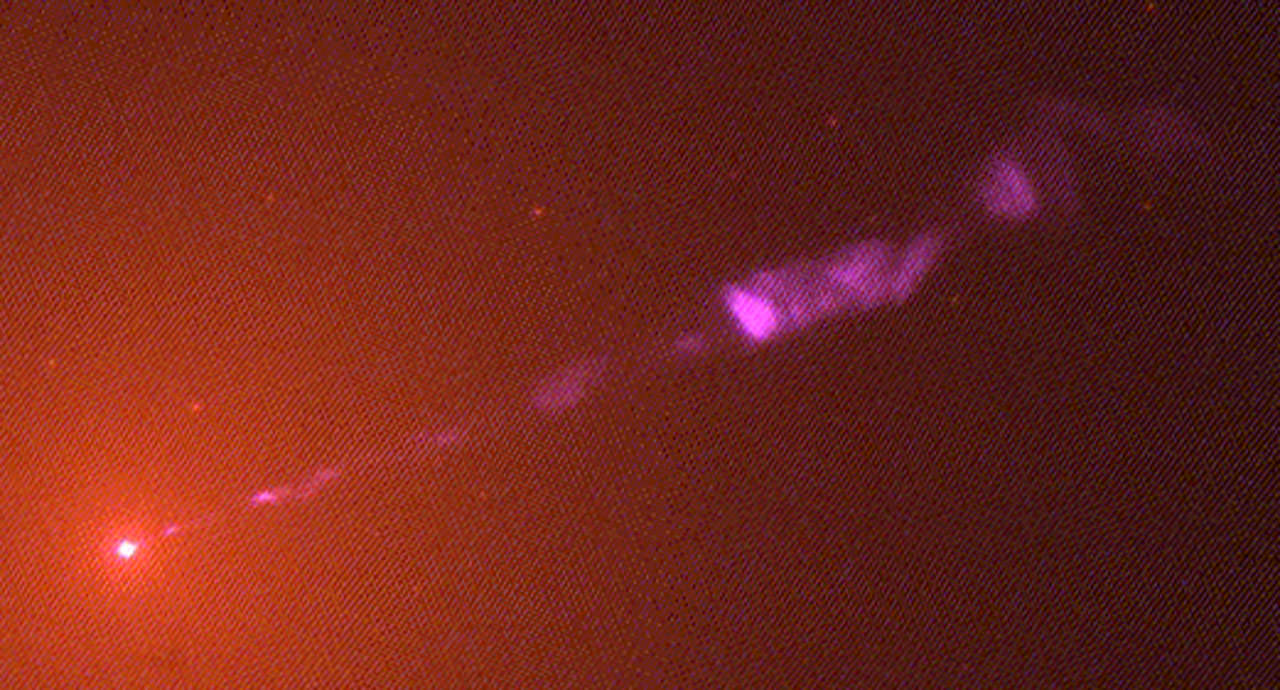Today, of course, we’re going to talk about the announcement from the Event Horizon Telescope and the first photograph of a black hole’s event horizon.
Continue reading “Ep. 526: Event Horizon Telescope and the Black Hole at M87”
It’s Finally here. The First Ever Image of a Black Hole

“We have taken the first picture of a black hole.”
EHT project director Sheperd S. Doeleman of the Center for Astrophysics | Harvard & Smithsonian.
What was once un-seeable can now be seen. Black holes, those difficult-to-understand singularities that may reside at the center of every galaxy, are becoming seeable. The Event Horizon Telescope (EHT) has revealed the first-ever image of a black hole, and with this image, and all the science behind it, they may help crack open one of the biggest mysteries in the Universe.
Continue reading “It’s Finally here. The First Ever Image of a Black Hole”How Massive Can Black Holes Get?
We talk about stellar mass and supermassive black holes. What are the limits? How massive can these things get?
Without the light pressure from nuclear fusion to hold back the mass of the star, the outer layers compress inward in an instant. The star dies, exploding violently as a supernova.
All that’s left behind is a black hole. They start around three times the mass of the Sun, and go up from there. The more a black hole feeds, the bigger it gets.
Terrifyingly, there’s no limit to much material a black hole can consume, if it’s given enough time. The most massive are ones found at the hearts of galaxies. These are the supermassive black holes, such as the 4.1 million mass nugget at the center of the Milky Way. Astronomers figured its mass by watching the movements of stars zipping around the center of the Milky Way, like comets going around the Sun.
There seems to be supermassive black holes at the heart of every galaxy we can find, and our Milky Way’s black hole is actually puny in comparison. Interstellar depicted a black hole with 100 million times the mass of the Sun. And we’re just getting started.
The giant elliptical galaxy M87 has a black hole with 6.2 billion times the mass of the Sun. How can astronomers possibly know that? They’ve spotted a jet of material 4,300 light-years long, blasting out of the center of M87 at relativistic speeds, and only black holes that massive generate jets like that.
Most recently, astronomers announced in the Journal Nature that they have found a black hole with about 12 billion times the mass of the Sun. The accretion disk here generates 429 trillion times more light than the Sun, and it shines clear across the Universe. We see the light from this region from when the Universe was only 6% into its current age.
Somehow this black hole went from zero to 12 billion times the mass of the Sun in about 875 million years. Which poses a tiny concern. Such as how in the dickens is it possible that a black hole could build up so much mass so quickly? Also, we’re seeing it 13 billion years ago. How big is it now? Currently, astronomers have no idea. I’m sure it’s fine. It’s fine right?
We’ve talked about how massive black holes can get, but what about the opposite question? How teeny tiny can a black hole be?

Astronomers figure there could be primordial black holes, black holes with the mass of a planet, or maybe an asteroid, or maybe a car… or maybe even less. There’s no method that could form them today, but it’s possible that uneven levels of density in the early Universe might have compressed matter into black holes.
Those black holes might still be out there, zipping around the Universe, occasionally running into stars, planets, and spacecraft and interstellar picnics. I’m sure it’s the stellar equivalent of smashing your shin on the edge of the coffee table.
Astronomers have never seen any evidence that they actually exist, so we’ll shrug this off and choose to pretend we shouldn’t be worrying too much. And so it turns out, black holes can get really, really, really massive. 12 billion times the mass of the Sun massive.
What part about black holes still make you confused? Suggest some topics for future episodes of the Guide to Space in the comments below.
‘Runaway’ Star Cluster Breaks Free from Distant Galaxy

We’ve discovered dozens of so-called “hypervelocity stars” — single stars that break the stellar speed limit. But today astronomers multiplied the number of these ‘runaway’ stars by hundreds of thousands. The Virgo Cluster galaxy, M87, has ejected an entire star cluster, throwing it toward us at more than two million miles per hour.
“Astronomers have found runaway stars before, but this is the first time we’ve found a runaway star cluster,” said lead author Nelson Caldwell of the Harvard-Smithsonian Center for Astrophysics, in a press release.
About one in a billion stars travel at a speed roughly three times greater than our Sun (which clocks in at 220 km/s with respect to the galactic center). At a speed that fast, these stars can easily escape the galaxy entirely, traveling rapidly throughout intergalactic space.
But this is the first time an entire star cluster has broken free.
What would cause an entire cluster — hundreds of thousands of stars packed together a million times more closely than in the neighborhood of our Sun — to reach such a tremendous speed?
Single hypervelocity stars have puzzled astronomers for years. But by observing their speed and direction, astronomers can trace these stars backward, finding that some began moving quickly in the Galactic Center. Here, an interaction with the supermassive black hole can kick a star away at an alarming speed. Another option is that a supernova explosion propelled a nearby star to a huge speed.
Caldwell and colleagues think M87 might have two supermassive black holes at its center. The star cluster wandered too close to the pair, which picked off many of the cluster’s outer stars while the inner core remained intact. The black holes then acted like a slingshot, flinging the cluster away at a tremendous speed.
The star cluster is moving so fast it should soon by sailing into intergalactic space. It may already be, but its distance remains unknown.
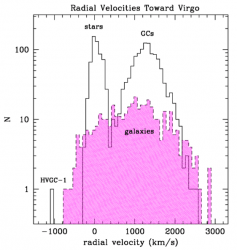
Image Credit: Caldwell et al.
The team found the globular cluster — dubbed HVGC-1 — with a stroke of luck. They had been analyzing 2,500 globular cluster candidates for years. While a computer algorithm automatically calculated the speed of every cluster, any oddity was analyzed by hand.
Over 1,000 candidates have measured velocities between 500 and 3000 km/s. These speeds are typical for Virgo Cluster members. But HVGC-1 has a radial velocity of -1026 km/s. “This is the most negative, bulk velocity ever measured for an astronomical object not orbiting another object,” writes Caldwell.
“We didn’t expect to find anything moving that fast,” said coauthor Jay Strader of Michigan State University.
Future measurements pinpointing the exact distance to the globular cluster will help shed light on its exact origins.
The paper will be published in The Astrophysics Journal Letters and is available for download here.
How Big Are Galaxies?
I’m going to refrain from the initial response that comes to mind… actually, no I won’t — they’re really, really, really big!!!!
</Kermit arms>
Ok, now that that’s out of the way check out this graphic by Arecibo astrophysicist Rhys Taylor, which neatly illustrates the relative sizes of 25 selected galaxies using images made from NASA and ESA observation missions… including a rendering of our own surprisingly mundane Milky Way at the center for comparison. (Warning: this chart may adversely affect any feelings of bigness you may have once held dear.) According to Taylor on his personal blog, Physicists of the Caribbean (because he works had worked at the Arecibo Observatory in Puerto Rico) “Type in ‘asteroid sizes’ into Google and you’ll quickly find a bunch of images comparing various asteroids, putting them all next to each at the same scale. The same goes for planets and stars. Yet the results for galaxies are useless. Not only do you not get any size comparisons, but scroll down even just a page and you get images of smartphones, for crying out loud.” So to remedy that marked dearth of galactic comparisons, Taylor made his own. Which, if you share my personal aesthetics, you’ll agree is quite nicely done.
“I tried to get a nice selection of well-known, interesting objects,” Taylor explains. “I was also a little limited in that I needed high-resolution images which completely mapped the full extent of each object… still, I think the final selection has a decent mix, and I reckon it was a productive use of a Saturday.” And even with the dramatic comparisons above, Taylor wasn’t able to accurately portray to scale one of the biggest — if not the biggest — galaxies in the observable universe: IC 1101.
For an idea of how we measure up to that behemoth, he made this graphic:
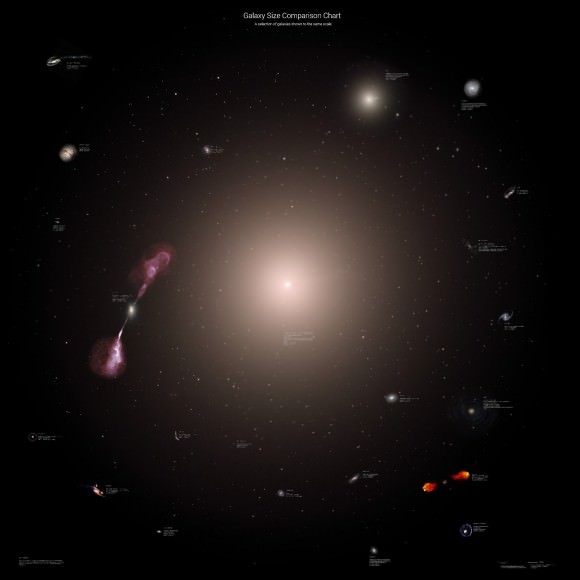
That big bright blur in the center? That’s IC 1101, the largest known galaxy — in this instance created by scaling up an image of M87, another supersized elliptical galaxy that just happens to be considerably closer to our own (and thus has had clearer images taken of it.) But the size is right — IC 1101 is gargantuan.
At an estimated 5.5 million light-years wide, over 50 Milky Ways could fit across it! And considering it takes our Solar System about 225 million years to complete a single revolution around the Milky Way… well… yeah. Galaxies are big. Really, really, really, really big!
</Kermit arms>
Now if you’ll pardon me, I need to go stop my head from spinning… Read this and more on Rhys Taylor’s blog here, and add Rhys to your awesome astronomy Google+ circles here. And you can find out more about IC 1101 in the video below from Tony Darnell, aka DeepAstronomy:
Black Hole Jets Might Be Molded by Magnetism
Visible-light Hubble image of the jet emitted by the 3-billion-solar-mass black hole at the heart of galaxy M87 (Feb. 1998) Credit: NASA/ESA and John Biretta (STScI/JHU)
Even though black holes — by their definition and very nature — are the ultimate hoarders of the Universe, gathering and gobbling up matter and energy to the extent that not even light can escape their gravitational grip, they also often exhibit the odd behavior of flinging vast amounts of material away from them as well, in the form of jets that erupt hundreds of thousands — if not millions — of light-years out into space. These jets contain superheated plasma that didn’t make it past the black hole’s event horizon, but rather got “spun up” by its powerful gravity and intense rotation and ended up getting shot outwards as if from an enormous cosmic cannon.
The exact mechanisms of how this all works aren’t precisely known as black holes are notoriously tricky to observe, and one of the more perplexing aspects of the jetting behavior is why they always seem to be aligned with the rotational axis of the actively feeding black hole, as well as perpendicular to the accompanying accretion disk. Now, new research using advanced 3D computer models is supporting the idea that it’s the black holes’ ramped-up rotation rate combined with plasma’s magnetism that’s responsible for shaping the jets.
In a recent paper published in the journal Science, assistant professor at the University of Maryland Jonathan McKinney, Kavli Institute director Roger Blandford and Princeton University’s Alexander Tchekhovskoy report their findings made using computer simulations of the complex physics found in the vicinity of a feeding supermassive black hole. These GRMHD — which stands for General Relativistic Magnetohydrodynamic — computer sims follow the interactions of literally millions of particles under the influence of general relativity and the physics of relativistic magnetized plasmas… basically, the really super-hot stuff that’s found within a black hole’s accretion disk.
Read more: First Look at a Black Hole’s Feast
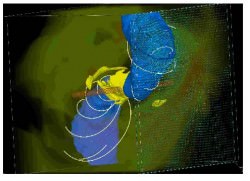 What McKinney et al. found in their simulations was that no matter how they initially oriented the black hole’s jets, they always eventually ended up aligned with the rotational axis of the black hole itself — exactly what’s been found in real-world observations. The team found that this is caused by the magnetic field lines generated by the plasma getting twisted by the intense rotation of the black hole, thus gathering the plasma into narrow, focused jets aiming away from its spin axes — often at both poles.
What McKinney et al. found in their simulations was that no matter how they initially oriented the black hole’s jets, they always eventually ended up aligned with the rotational axis of the black hole itself — exactly what’s been found in real-world observations. The team found that this is caused by the magnetic field lines generated by the plasma getting twisted by the intense rotation of the black hole, thus gathering the plasma into narrow, focused jets aiming away from its spin axes — often at both poles.
At farther distances the influence of the black hole’s spin weakens and thus the jets may then begin to break apart or deviate from their initial paths — again, what has been seen in many observations.
This “magneto-spin alignment” mechanism, as the team calls it, appears to be most prevalent with active supermassive black holes whose accretion disk is more thick than thin — the result of having either a very high or very low rate of in-falling matter. This is the case with the giant elliptical galaxy M87, seen above, which exhibits a brilliant jet created by a 3-billion-solar-mass black hole at its center, as well as the much less massive 4-million-solar-mass SMBH at the center of our own galaxy, Sgr A*.
Read more: Milky Way’s Black Hole Shoots Out Brightest Flare Ever
Using these findings, future predictions can be better made concerning the behavior of accelerated matter falling into the heart of our galaxy.
Read more on the Kavli Institute’s news release here.
Inset image: Snapshot of a simulated black hole system. (McKinney et al.) Source: The Kavli Institute for Particle Astrophysics and Cosmology (KIPAC)
Cosmic Volcano Erupting in M87
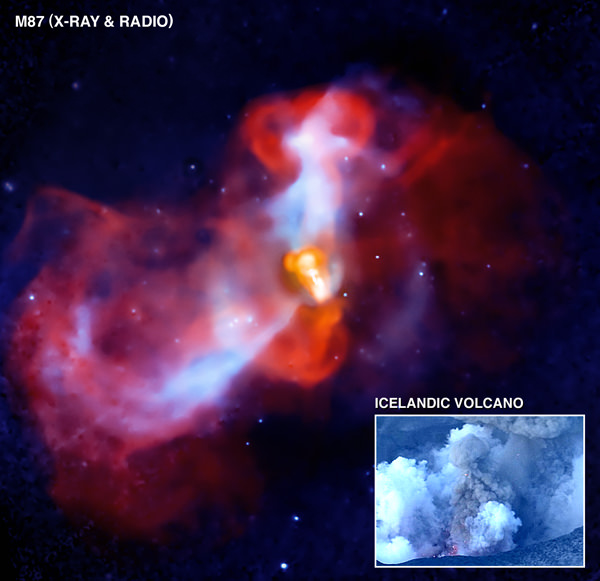
[/caption]
It’s the Eyjafjallajokull of space! Chandra and the VLA have teamed up to find an erupting galactic “super-volcano” in the massive galaxy M87. Hot gas glowing in X-ray light (shown in blue) surrounds M87, and as the gas cools, it can fall toward the galaxy’s center where it should continue to cool even faster and form new stars. But radio observations with the Very Large Array (red-orange) suggest that in M87 jets of very energetic particles produced by the black hole interrupt this process. These jets lift up the relatively cool gas near the center of the galaxy and produce shock waves in the galaxy’s atmosphere because of their supersonic speed. Scientists say this action is similar to what took place with the Eyjafjallajokull volcano in Iceland that occurred in 2010.
With Eyjafjallajokull, pockets of hot gas blasted through the surface of the lava, generating shock waves that can be seen passing through the grey smoke of the volcano. This hot gas then rises up in the atmosphere, dragging the dark ash with it. Remember the close-up movie of the volcano’s eruption — (see below)? Shock waves propagating in the smoke are followed by the rise of dark ash clouds into the atmosphere.
In the case of this cosmic volcano in M87, the energetic particles produced in the vicinity of the black hole rise through the X-ray emitting atmosphere of the cluster, lifting up the coolest gas near the center of M87 in their wake. This is similar to the hot volcanic gases that drag up the clouds of dark ash. And just like the volcano here on Earth, shock waves can be seen when the black hole pumps energetic particles into the cluster gas. The Chandra team has provided a labeled version of the image which shows the energetic particles, cool gas and shock waves.
M87 is about 50 million light years from Earth and lies at the center of the Virgo cluster, which contains thousands of galaxies.
Source: Chandra
Black Hole in M87 Wanders using Jetpack
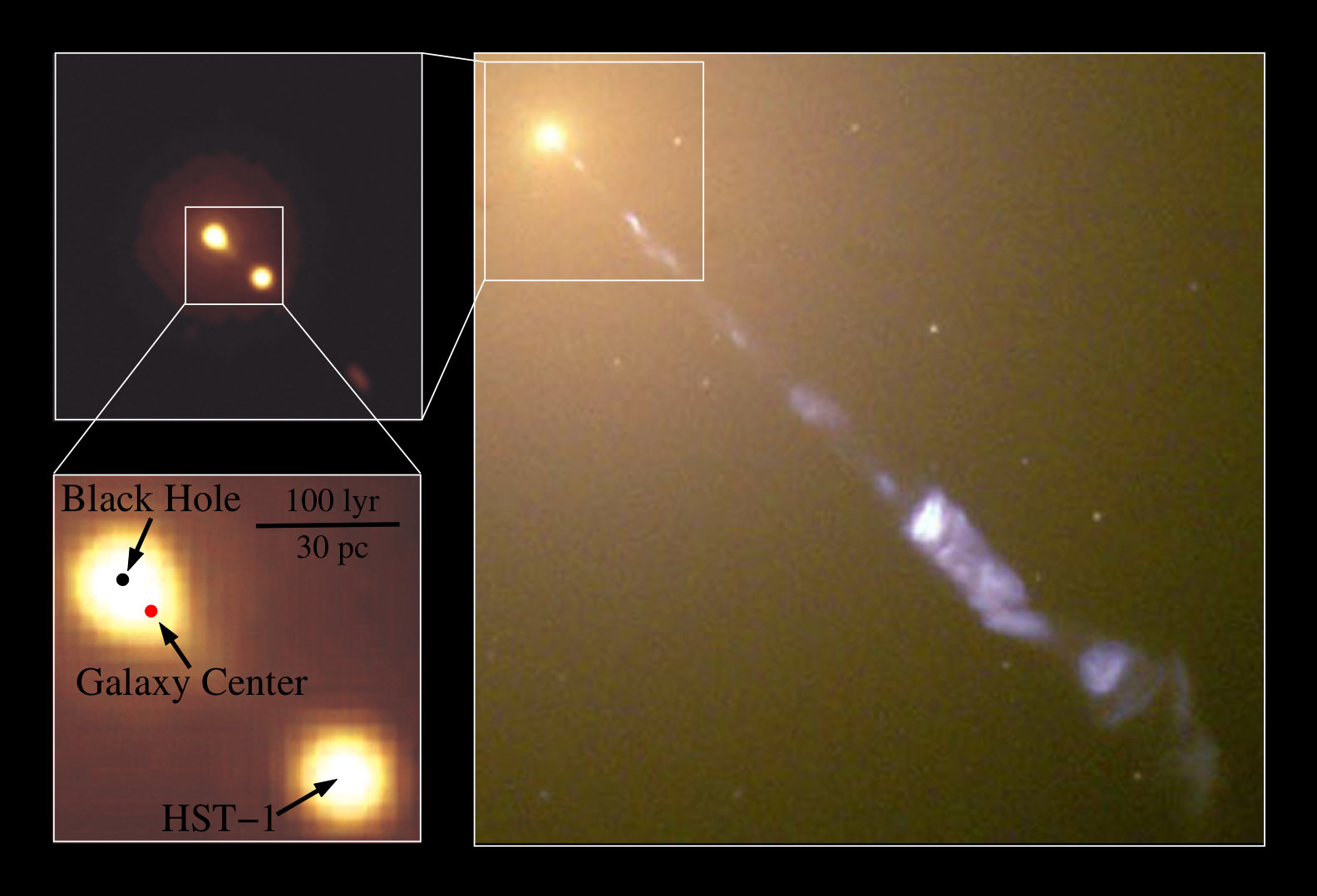
[/caption]
The elliptical galaxy M87 is known for a jet of radiation that is streaming from the supermassive black hole (SMBH) that the galaxy houses. This jet, which is visible through large-aperture telescopes, may have functioned as a black hole ‘jetpack’, moving the SMBH from the center of mass of the galaxy – where most SMBHs are thought to reside.
Observations taken with the Hubble Space Telescope by a collaboration of astronomy researchers at Rochester Institute of Technology, Florida Institute of Technology and University of Sussex in the United Kingdom show the SMBH in M87 to be displaced from the center of the galaxy by as much as 7 parsecs (22.82 light years). This contradicts the long-held theory that supermassive black holes reside at the center of the galaxies they inhabit, and may give astronomers one way to trace the history of galaxies that have grown through merging.
What caused M87’s SMBH to wander off so far from the center of the galaxy? The most likely cause is a merger between two smaller supermassive black holes sometime in the past. This merger could have created gravitational waves that gave the engorged black hole a swift kick. Elliptical galaxies like M87 are thought to become the size they are through the merger of smaller galaxies.
Another theory is that the jet of radiation that sprays out of the SMBH has pushed with enough energy to essentially propel the black hole away from the center of M87. Okay, so it’s not really a ‘black hole jetpack’, but you have to admit that the combination of black holes – which are cool – and jetpacks, also cool, is too good to pass up. The motion of the SMBH happens to be in the opposite direction of the jet that we can see streaming from the object. For this scenario to be true, however, the jet would have to have been much more energetic millions of years ago, the researchers concluded.
There also does exist evidence for another jet of material that is streaming out of the other side of the SMBH, which would cancel the pushing motion of the jet that we can see, making the merger scenario much more likely. If the two jets were asymmetric to a high degree, however, this scenario still may be the case. More information on the structure and history of the jets would better clarify the cause of the black hole’s displacement.
This study of M87 is part of a wider project aimed at constraining the placement of supermassive black holes, also known as Active Galactic Nuclei or quasars, in their home galaxies. David Axon, dean of mathematical and physical sciences at Sussex, said in a press release, “In current galaxy formation scenarios galaxies are thought to be assembled by a process of merging. We should therefore expect that binary black holes and post coalescence recoiling black holes, like that in M87, are very common in the cosmos.”
The displacement of such black holes would be apparent in archived Hubble Space Telescope images, and the researchers that discovered this phenomenon in M87 used the HST archives to pinpoint the location of the SMBH. Further analysis of these archives could yield many, many more ‘wandering’ black holes.
These findings were presented on May 25th at the American Astronomical Society meeting in Miami, Florida. The team of researchers that collaborated on the finding include Daniel Batcheldor and Eric Perlman of the Florida Institute of Technology, Andrew Robinson and David Merritt of the Rochester Institute of Technology and David Axon of the University of Sussex. Their results were accepted for publication in Astrophysical Journal Letters, and the original paper, A Displaced Supermassive Black Hole in M87, is available on Arxiv right here.
Source: Eurekalert, Arxiv, Eric Perlman’s website



